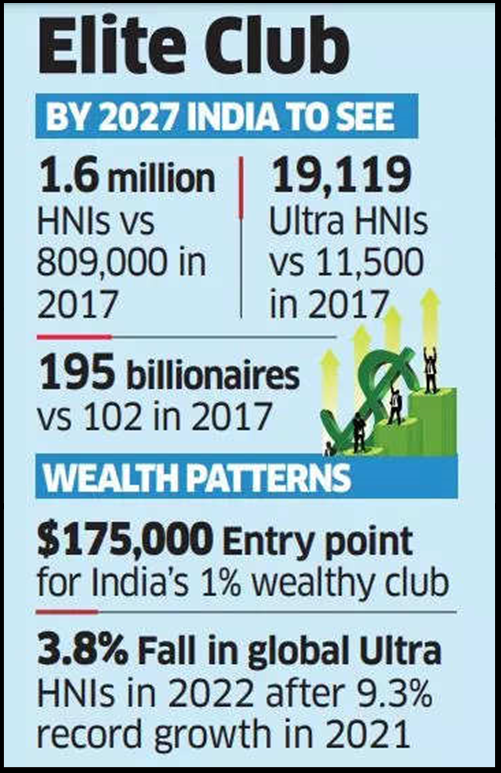SEDUCE HNIS, BETTER INDIA
Syllabus:
GS 2:
- Indian Economy and issues relating to planning, mobilization, of resources, growth, development and employment.
Focus:
- Political Uncertainties stemming from political interference, bureaucratic red tape and fluctuating policies also contribute to the discomfort of India’s wealthy.
Source:- The Economics Times
Governance and Legal Framework
- Establish Stable Governance: Emphasize the importance of a stable, efficient, and fair governance framework to instill confidence among HNIs.
- Predictable Legal Environment: Ensure a predictable legal system with impartial enforcement and swift dispute resolutions.
- Reduce Bureaucracy: Streamline bureaucratic processes to make the business environment more welcoming.
- Transparency and Anti-corruption Measures: Implement stringent anti-corruption measures to foster a transparent business ecosystem.
Economic Incentives
- Competitive Tax Regime: Design a competitive tax policy that is attractive to wealth generators, balancing the need for public funding with incentives for wealth retention and attraction.
- Stable Economic Policies: Ensure consistency and predictability in economic policies to encourage long-term investment and growth.
- Financial Services and Investment Opportunities: Enhance the sophistication of financial services and present lucrative investment opportunities to retain and attract HNIs.
Cultural and Social Inclusivity
- Promote Diversity and Tolerance: Foster a society that values cultural and social diversity, making it appealing for individuals from various backgrounds.
- Safety and Respect for All: Prioritize safety and ensure respect for women and minorities to create a secure and respectful environment.
- Community and Diaspora Engagement: Leverage India’s vast diaspora to build networks that support and attract HNIs, highlighting the country’s cultural vibrancy and inclusivity.
Quality of Life Improvements
- Environmental Quality: Invest in pollution control and environmental management to improve air and water quality.
- Healthcare and Education: Develop world-class healthcare facilities and educational institutions to match global standards.
- Urban Infrastructure: Upgrade urban infrastructure, including housing, transportation, and public amenities, to enhance living conditions.
- Cultural and Recreational Amenities: Promote cultural richness and recreational options, including theaters, galleries, concerts, and dining, to appeal to a global elite.
Infrastructure and Public Services
- Efficient Transportation Systems: Build efficient and rapid transportation systems to ease commuting and improve connectivity.
- Urban Planning and Development: Adopt modern urban planning techniques to develop smart cities that cater to the needs of HNIs.
- Public Services Enhancement: Significantly improve public services like sanitation, waste management, and water supply to match international standards.
- Investment in Public Safety: Enhance public safety measures to create a secure environment for residents and visitors.
Holistic Development Approach
- Civic Education and Values: Incorporate civic education into curricula to foster a sense of responsibility and community engagement among citizens.
- Promotion of Arts and Culture: Support the arts and cultural heritage to showcase India’s rich traditions and contemporary creativity.
- Technological Innovation and Support: Encourage technological innovation and provide support for startups and tech ventures to create a dynamic economic environment.
Economic Development and Policy Reform
- Ease of Doing Business: Continue reforms to improve the ease of doing business ranking, making India more attractive for domestic and international investors.
- R&D and Innovation Incentives: Offer incentives for research and development, particularly in sectors like technology, healthcare, and green energy.
- Support for Entrepreneurship: Provide robust support systems for entrepreneurs, including funding, mentorship, and regulatory ease, to foster a vibrant startup ecosystem.
International Collaboration and Exchange
- Foster Global Partnerships: Strengthen international collaborations in trade, investment, education, and technology to enhance India’s global standing.
- Exchange Programs: Implement cultural and educational exchange programs to build bridges between Indian and global communities.
Monitoring and Evaluation
- Track Migration Trends: Continuously monitor the migration trends of HNIs to understand their concerns and motivations better.
- Feedback Mechanisms: Establish feedback mechanisms to gather insights from HNIs and expatriates about their experiences and suggestions for improvement.
- Policy Adaptation and Flexibility: Remain adaptable in policy-making to swiftly respond to global economic changes and HNIs’ evolving needs.
Implementing these strategies requires a concerted effort from the government, private sector, civil society, and the Indian diaspora. By addressing the key factors that influence the migration decisions of HNIs, India can create a more attractive environment for retaining and attracting global wealth. This, in turn, will not only contribute to economic growth but also enhance the quality of life for all its citizens, paving the way for India to emerge as a strong and vibrant global economy.
Types of High-Net-Worth Individuals (HNIs)
Outflow of HNIs
Reasons for HNWIs Leaving India
Top Destinations for Indian Millionaires
|
Source:
The Economics Times
Mains Practice Question:
“Discuss the impact of High-Net-Worth Individuals (HNIs) migrating from India on the country’s economic development and social fabric. Analyze the effectiveness of current policies in retaining and attracting HNIs, and suggest measures for creating a conducive environment for their retention. Consider governance, economic incentives, and quality of life improvements in your answer.”




